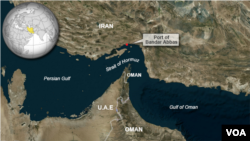Iranian forces have seized a cargo ship traveling under the flag of the Pacific island nation of the Marshall Islands. The Pentagon says the ship remains off the coast of Iran as the U.S. military monitors the situation.
Pentagon spokesman Colonel Steve Warren says the Maersk Tigris cargo ship was using an international waterway in the Strait of Hormuz when patrol vessels of the Iranian Revolutionary Guard Corps Navy approached.
“This part of the Strait of Hormuz apparently is in Iranian territorial waters; however, because it is recognized as an international shipping lane, something called ‘innocent passage’ is applied, so ships, assuming that they abide by all of the laws of the sea are, according to international standards, authorized to pass through this Strait," said Warren.
The Pentagon says the ship’s master was contacted by Iranian forces and told to move further into Iranian territory. When he refused, one of the patrol vessels fired shots across the bridge of the ship. The master of the ship then complied with the demands and headed off the coast of Iran’s Larak Island.
The Pentagon says Iranians boarded the ship and appear to still remain onboard.
Warren said that while it is too early to tell if this is considered a disruption of international shipping traffic, Iran should not have fired across the vessel.
“It is inappropriate," he said.
'Complex legal questions'
Warren said the container ship was in Iranian waters when it was approached.
"The [ship]master was contacted and directed to proceed further [farther] into Iranian territorial waters," Warren said. "He declined and one of the IRGCN craft fired shots across the bridge of the Maersk Tigris. The master complied with the Iranian demand and proceeded into Iranian waters in the vicinity of Larak Island."
Warren described the situation as a “complex legal question."
“This part of the Strait of Hormuz apparently is in Iranian territorial waters. It’s within 12 miles [19 km] of the Iranian coast. However, because it is recognized as an international shipping lane, something called ‘innocent passage’ is applied,” Warren added. “So ships, assuming that they abide by all the laws of the sea are, according to international standards, authorized to pass through this strait.”
The spokesman said that while it is too early to tell if the action represents a disruption of international shipping traffic, Iran should not have fired across the vessel, describing the shots as "inappropriate."
Pentagon officials said a U.S. guided-missile destroyer, the USS Farragut, is en route to the area.
Aircraft observing interactions
U.S. Naval Forces Central Command has also "directed aircraft to observe the interaction between the Maersk vessel and the IRGCN [Islamic Revolutionary Guard Corps Navy] craft."
U.S. officials have been in touch with representatives of the shipping company, who said Iranian forces have boarded the vessel.
A senior administration official said the container ship issued a distress call but that the call came after shots had been fired.
U.S. officials said no Americans were on board.
A State Department spokesman said the safety of navigation in the area was "a key concern" and noted that the U.S. has a security pact with the Republic of the Marshall Islands. He said it was premature to speculate that the pact would obligate any use of force by the U.S.
He also said that it was premature to say the incident would have any impact on international talks on Iran's nuclear program.
Iran has in the past sometimes threatened to block the strait to advance its opposition to sanctions related to its nuclear program.
The channel is a narrow strip of water separating Oman and Iran. It connects the biggest Gulf oil producers, such as Saudi Arabia, with the Gulf of Oman and the Arabian Sea.
At its narrowest point, the strait is 33 kilometers (21 miles) across and consists of 3-kilometer-wide navigable channels for inbound and outbound shipping and a 3-kilometer-wide buffer zone.
VOA's Carla Babb, Jeff Seldin and Pam Dockins contributed to this report. Some material came from Reuters.




